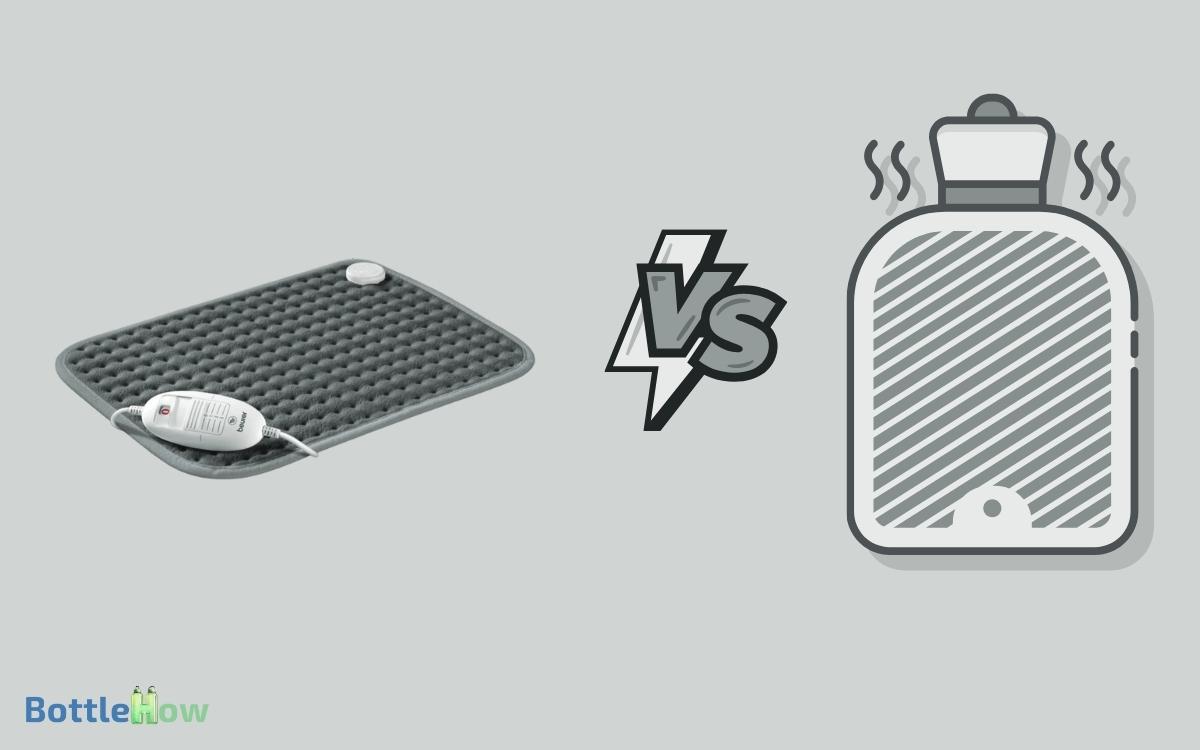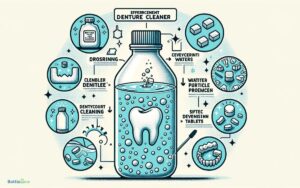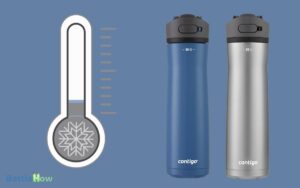Heat Pad Vs Hot Water Bottle: Which One Better for You?
Both heat pads and hot water bottles are effective for pain relief. Heat pads provide continuous, adjustable heat for targeted muscle spasms or joint stiffness and are convenient with battery-operated models.
Hot water bottles offer broad, soothing warmth, ideal for menstrual cramps and falling asleep. They’re economical since they don’t require electricity.
However, heat pads minimize burn risks and are easier to prepare, while hot water bottles can maintain warmth without electrical needs but require careful handling to avoid burns.
Understanding these aspects will help you choose the best option for your needs. Discover more about their specific advantages and limitations.

Key Takeaways
Comparison of Heat Pad and Hot Water Bottle
| Feature | Heat Pad | Hot Water Bottle |
|---|---|---|
| Heat Source | Electrically powered heating elements | Filled with hot water |
| Heating Method | Typically offers consistent, regulated heat | Heat dissipates gradually over time |
| Temperature Control | Often comes with adjustable settings | Temperature determined by initial water |
| Duration | Can provide continuous heat for extended periods of time | Gradually loses heat over several hours, requiring reheating as needed |
| Safety | Generally considered safe when used properly | Risk of burns if water is too hot or bottle is damaged |
| Portability | Requires access to electricity | Portable when filled with hot water, but less convenient for travel |
| Reusability | Can be used repeatedly without degradation of heating elements | Can be refilled with hot water multiple times before needing replacement |
| Comfort | Often designed with soft, plush covers for added comfort | Provides warmth and comfort, but may require additional cover for direct skin contact |
| Cost | Generally more expensive upfront, but lower operating costs over time | Relatively inexpensive upfront, but ongoing cost of hot water |
Heat Pad Benefits
When you use a heat pad, it can provide targeted relief and promote muscle relaxation through consistent, adjustable warmth. Heat pads are particularly effective for alleviating chronic pain conditions such as arthritis and fibromyalgia.
They enhance blood circulation, which facilitates oxygen and nutrient delivery to tissues, thereby accelerating the healing process.
You can easily adjust the temperature to suit your comfort level, ensuring the best therapeutic benefits.
Unlike some other methods, heat pads offer sustained warmth without the risk of burns, as modern designs include safety features like auto-shutoff.
Additionally, their portability allows you to apply heat therapy conveniently while engaging in daily activities, contributing to overall pain management and enhanced quality of life.
Hot Water Bottle Advantages
You’ll find that hot water bottles offer several significant advantages, especially when it comes to portability and convenience.
They provide a cost-effective solution for pain relief, requiring no electricity. Additionally, they deliver long-lasting warmth, ensuring sustained therapeutic benefits.
Portability And Convenience
Carrying a hot water bottle offers unparalleled convenience due to its lightweight design and ease of use. Whether you’re at home, in the office, or traveling, it provides instant warmth and comfort without requiring electricity. When comparing a hot water bottle vs rice bag, the hot water bottle retains heat for longer periods and can be easily refilled as needed. Its durable material ensures repeated use, making it a reliable choice for soothing aches or keeping warm on chilly nights.
Whether managing localized pain or seeking warmth, you’ll appreciate its portability and straightforward application. You simply fill it with hot water, and it’s ready to go, making it ideal for travel or home use.
| Feature | Hot Water Bottle | Heat Pad |
|---|---|---|
| Weight | Light | Variable |
| Setup Time | Minimal | Moderate |
| Mobility | High | Limited by cord |
Hot water bottles don’t require electricity, making them a practical choice in areas with limited power sources.
They’re also compact, easily fitting into bags or suitcases. This makes them an excellent option for patients needing immediate and accessible heat therapy.
Cost-Effective Solution
A hot water bottle offers a highly cost-effective solution for patients seeking affordable heat therapy.
You don’t need to invest in expensive electric heating pads; a simple hot water bottle can provide effective relief. The initial cost is minimal, with durable options often available at low prices.
Additionally, there are no ongoing electricity costs, making it an economical choice over time. For those managing chronic pain or muscle tension, this option allows you to access consistent heat therapy without financial strain.
Clinical studies have demonstrated that hot water bottles can be just as effective as other heat modalities in managing pain and promoting relaxation.
Opting for a hot water bottle can be a practical and budget-friendly approach to heat therapy.
Long-Lasting Warmth
Hot water bottles provide long-lasting warmth, maintaining a therapeutic temperature for extended periods, which is essential for sustained pain relief and muscle relaxation.
You’ll benefit from the consistent heat that targets sore muscles or joints, enhancing blood flow and reducing discomfort.
Unlike electric heat pads, hot water bottles gradually cool down, preventing overheating and minimizing the risk of burns.
This natural heat retention can be especially advantageous during cold nights, ensuring you stay warm without constant electricity.
Additionally, the portability of hot water bottles allows you to apply heat precisely where needed. By choosing a hot water bottle, you’re opting for a reliable, enduring source of warmth that can effectively support your pain management and comfort needs.
Drawbacks of Heat Pads
One major drawback of heat pads is the importance of avoiding burns due to prolonged use or malfunction.
If you use a heat pad for extended periods or at a high temperature, you could experience skin irritation or even thermal burns. Some heat pads may malfunction, leading to uneven heating or overheating, which increases burn risk.
Additionally, certain medical conditions, such as diabetes, can impair sensation, making it harder to notice excessive heat.
Always follow manufacturer guidelines and check the device regularly to make sure it’s functioning correctly. Consider setting a timer to limit use and prevent overheating.
While heat pads can provide relief, it’s essential to use them safely to avoid these potential complications.
Cons of Hot Water Bottles
Using hot water bottles can pose several risks, including the potential for burns and the challenge of maintaining a consistent temperature. You might find that these drawbacks make them less ideal for pain management and comfort.
- Burns and scalds: If the water is too hot or the bottle leaks, you’re at risk for thermal injuries.
- Temperature control: It’s difficult to maintain a steady temperature, which can lead to discomfort or ineffective therapy.
- Material degradation: Over time, the rubber material can degrade, increasing the risk of leaks and rupture.
- Limited heat duration: Hot water bottles tend to lose heat relatively quickly, necessitating frequent refills.
Considering these points, you may need to weigh these risks carefully when deciding whether to use a hot water bottle.
Usage and Convenience
When considering ease of preparation, heat pads generally offer more convenience since they only require plugging in, whereas hot water bottles necessitate boiling water.
Portability is another factor; heat pads are lightweight and often more compact compared to hot water bottles.
Lastly, in terms of storage, heat pads can be easily folded or rolled, whereas hot water bottles may take up more space and require careful handling to avoid leaks.
Ease of Preparation
Compared to hot water bottles, heat pads offer a more straightforward and user-friendly preparation process, eliminating the risk of burns from boiling water.
With heat pads, you simply plug them into an electrical outlet or microwave them for a few minutes.
This process minimizes effort and maximizes safety, making them ideal for patients with limited mobility or dexterity.
On the other hand, hot water bottles require careful handling of boiling water, which can pose a hazard.
- Minimal effort: Plug in or microwave, no boiling required.
- Reduced risk: Eliminates exposure to potentially scalding water.
- Convenience: Suitable for quick use, requiring minimal preparation time.
- Safety: Ideal for individuals with mobility or dexterity issues.
Heat pads clearly provide a safer, more convenient option for patients seeking therapeutic heat.
Portability and Storage
While heat pads excel in ease of preparation, their portability and storage also offer significant advantages for patient use.
You’ll find that heat pads are typically lightweight and compact, making them easier to transport compared to bulky hot water bottles.
Many heat pads are designed with flexible materials, allowing them to conform to various body parts, enhancing comfort during use. Additionally, you won’t need to worry about potential leaks or burns from hot water.
Storage is straightforward; most heat pads can be neatly folded or rolled, taking up minimal space in your home.
They often come with convenient carrying cases, ensuring they remain clean and ready for use. These features make heat pads a practical choice for on-the-go pain management.
Best Situations for Each
Heat pads excel in providing targeted relief for chronic pain conditions, making them ideal for conditions like arthritis or back pain.
Their consistent and adjustable heat settings allow for precise temperature control, ensuring best therapeutic benefits.
Use heat pads when you need:
- Localized treatment for muscle spasms or joint stiffness
- Continuous heat without the need for frequent reheating
- Portability with options like battery-operated models
- Adjustability for customized heat levels
On the other hand, hot water bottles are perfect for short-term, generalized warmth. They’re great for:
- Bedtime warmth to help you fall asleep
- Menstrual cramps due to their broad, soothing heat
- Economical use without electricity
- Natural, moist heat that can penetrate deeper tissues
Choose based on your specific needs for effective pain management.
Conclusion
Imagine choosing between a heat pad and a hot water bottle as deciding on the right tool for the job.
Just like a surgeon selects the best instrument for a procedure, you should consider your specific needs.
Both have their merits—heat pads offer consistent warmth, while hot water bottles provide a comforting, tactile experience.
Ultimately, your personal comfort and convenience should guide your choice, ensuring you get the therapeutic benefits you need.





